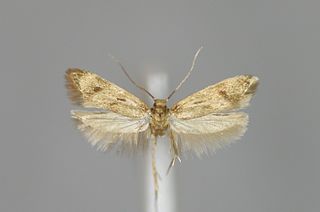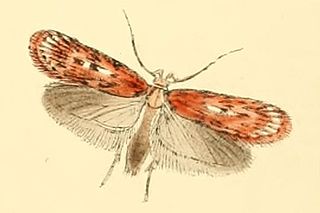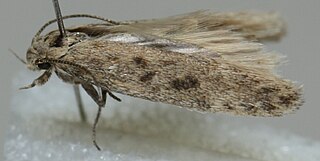Related Research Articles
Encentrotis is a genus of moths in the family Gelechiidae. It contains the species Encentrotis catagrapha, which is found in South Africa.

Elophila nymphaeata, the brown china mark, is a species of moth of the family Crambidae. It was described by Carl Linnaeus in his 1758 10th edition of Systema Naturae. It is found in Europe. The moth is notable as its larva, like most members of the crambid subfamily Acentropinae, is aquatic and has tracheal gills.

Borkhausenia fuscescens is a moth of the family Oecophoridae. It is found in Europe.

Apamea lateritia, the scarce brindle, is a moth of the family Noctuidae. It is found in much of the Palearctic. It is a sporadic migrant in Great Britain, where it is recorded from the east and south-east coasts.

Stigmella continuella is a moth of the family Nepticulidae. It is found from Fennoscandia to the Pyrenees, Alps and Hungary, and from Ireland to central Russia and Ukraine, east to the eastern part of the Palearctic realm.
Batrachedra plagiocentra is a species of moth of the family Batrachedridae. It is found in Australia.

Depressaria pulcherrimella is a moth of the family Depressariidae. It is found in most of Europe, except the Balkan Peninsula.

Dichrorampha alpinana, the broad-blotch drill, is a species of moth of the family Tortricidae. It is found in almost all of Europe.

Scrobipalpa obsoletella, the summer groundling, is a moth of the family Gelechiidae. It is found in most of Europe, Turkey, the Caucasus, from Iran to Asian Russia (Transbaikal) and Mongolia. It has also been recorded from South Africa and North America, where it is probably an introduced species. The habitat consists of coastal salt marshes and sandy beaches.
Agonopterix epichersa is a moth in the family Depressariidae. It was described by Edward Meyrick in 1914. It is found in Sichuan, China.
Ardozyga trochias is a species of moth in the family Gelechiidae. It was described by Edward Meyrick in 1921. It is found in Australia, where it has been recorded from Queensland.
Kiwaia aerobatis is a moth in the family Gelechiidae. It was described by Edward Meyrick in 1924. It is found in New Zealand.
Mnesistega convexa is a moth in the family Gelechiidae. It was described by Edward Meyrick in 1923. It is found in Assam, India.
Autosticha ansata is a moth in the family Autostichidae. It was described by Edward Meyrick in 1931. It is found in Chennai, India.
Autosticha emmetra is a moth in the family Autostichidae. It was described by Edward Meyrick in 1921. It is found in Zimbabwe.
Glyphidocera barythyma is a moth in the family Autostichidae. It was described by Edward Meyrick in 1929. It is found in North America, where it has been recorded from Florida, Indiana and Texas.
Chlamydastis funicularis is a moth of the family Depressariidae. It is found in French Guiana.
Stenoma pertinax is a moth of the family Depressariidae. It is found in Peru.
Lecithocera excaecata is a moth in the family Lecithoceridae. It was described by Edward Meyrick in 1922. It is found on Java in Indonesia.
Tiquadra syntripta is a moth of the family Tineidae. It is known from Brazil.